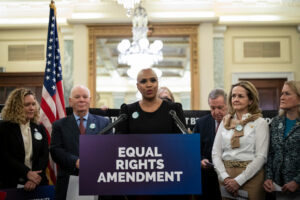There’s a Way to Add the Equal Rights Amendment to the Constitution – And We Did It
The constitutional rights of women and queer people in this country are no joke. Can someone tell Boston Globe columnist Jeff Jacoby? In his opinion piece earlier this month declaring the death of the Equal Rights Amendment, Jacoby made several mistakes both in fact and law. We’re glad to report that the ERA is very much alive—so alive, in fact, there is a Senate Judiciary Committee hearing scheduled on it next week.
You don’t have to believe us, though. Take the word of one of the most preeminent constitutional legal scholars of our time, Harvard Professor Laurence Tribe, who told Congress, “My conclusion as a constitutional scholar is that the ERA is currently a valid part of the United States Constitution, that Congress should act concurrently to recognize it as such, and that even if Congress takes no such action the archivist should publish it as the [28th] Amendment.”
Contrary to Tribe, Jacoby argues that an initial deadline stands in the way of finalizing the validly-ratified ERA. But Congress never had the authority to set a deadline in the first place. The Constitution’s text is clear: Article V, which governs the amendment process, gives no authority for Congress to impose a time limit on the states to ratify. Amending deadlines are unconstitutional.
Even if you accept the initial 1979 deadline in the proposing clause of the ERA as valid (to be clear, we don’t), Jacoby ignores that it was already altered once by a simple majority in Congress. The 96th Congress voted to extend the deadline from 1979 to 1982. Congress moved the deadline once and it can do so again. A past Congress can never bind a future Congress. There are bipartisan bills both in the House and Senate currently pending that do just that.
The most recent amendment to the U.S. Constitution took over 200 years to get ratified. If 200 years is “sufficiently contemporaneous” for an amendment to make it into the U.S. Constitution, so are the 48 years it took to get the final state (Virginia) to ratify the ERA. When Virginia ratified, both Article V requirements were met. Two-thirds of both houses of Congress passed the ERA, and 38 states (three-fourths) ratified it. That’s all that’s required.
Jacoby points out that five states have attempted to rescind their ratifications. However, he conveniently left out the fact that the 14th Amendment was certified and published as part of the U.S. Constitution in 1868, despite the fact that two states purported to rescind their ratifications. Those states (Ohio and New Jersey) were counted among the ratifying states; their “rescissions” didn’t count. Tennessee also attempted to rescind its ratification of the women’s suffrage amendment. This attempt was ignored, and the 19th Amendment was certified and published on Aug. 26, 1920.
Jacoby tried to twist the words of the late Justice Ruth Bader Ginsburg to argue that we don’t really need the ERA. But, as we have seen with the Dobbs v. Jackson Women’s Health Organization decision overturning Roe v. Wade, gains we thought were long settled can be easily taken away if they are not cemented in the Constitution.
We have no de facto ERA to protect us. Arguing that the ERA is somehow “unneeded” belies the true motive of opponents of equality. If it was completely redundant, why would anti-ERA advocates spend precious time fighting against it? An amendment banning discrimination on the basis of sex in our most foundational document will make a monumental difference. That’s why they fear it.
